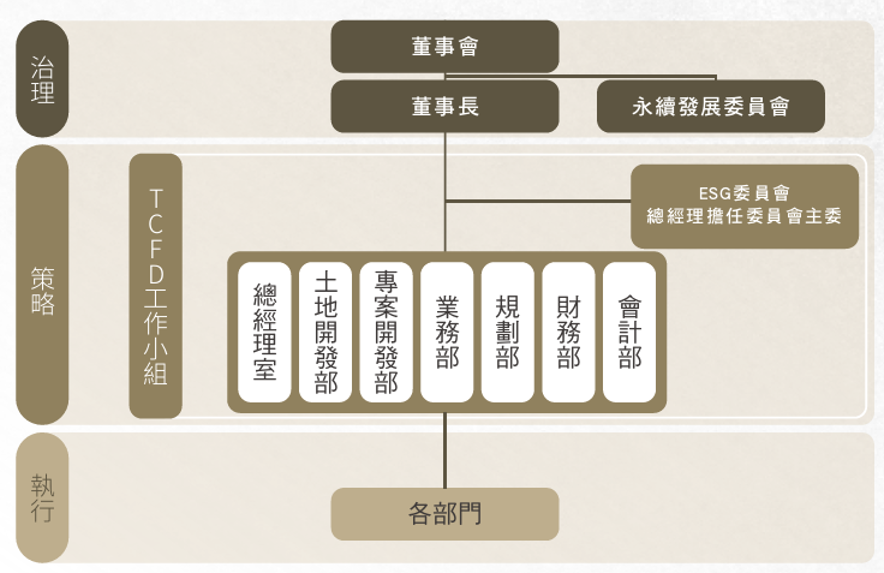In recent years, governments and companies around the world have responded to the 2050 net-zero emissions goal. Taiwan has also amended and passed the Climate Change Response Act. As regulations on greenhouse gas emissions and information disclosure become increasingly stringent both domestically and internationally, consumers and investors are placing greater emphasis on companies’ abilities to address climate change issues. Ruentex Development is highly in tune with trends in climate change and sustainable development. In addition to establishing a TCFD working group to manage risks and opportunities related to climate change, the Sustainability and Product Services group under the ESG Committee also includes environmental issues such as energy, water resources, circular economy, and waste management in its operations.
Ruentex Develpoment Environmental Management Policy
- Implement ISO 9001 and ISO 14001 management systems.
- Establish quality and environmental objectives, commit to achieving these objectives, and enable continuous improvement.
- All engineering activities, products, and services must comply with applicable regulations, ISO management systems, and other requirements.
- Commit to continuous improvement and pollution prevention in development and construction processes to minimize environmental impact.
- Incorporate green building considerations into the planning and design process to reduce environmental impact.
- Continue promoting energy management and effectively implement resource recycling.
- Educate and enhance all employees’ quality, environmental awareness, and capabilities.
- Establish customer service systems, promote customer satisfaction management, and enhance service philosophy for customer satisfaction.
- Ruentex Development has been a pioneer in the industry since 1999, implementing ISO14001 environmental management systems and obtaining third-party SGS external certification annually. We will also evaluate the introduction of relevant management systems for major environmental issues in the future.
Climate Governance
Ruentex Development Climate Governance Organizational Structure

For supervising climate-related issues of subsidiaries within the Group, Ruentex Development began holding Group sustainability meetings periodically starting in 2023, with a total of 10 meetings in 2024. Subsidiaries’ sustainable climate governance groups are required to report to the parent company, jointly monitoring the implementation status of related objectives and performance within the Group, maintaining consistent sustainable climate governance direction for the Ruentex Development Group.
Climate Risk and Opportunity Assessment and Response Strategies
List of Climate-Related Issues Relevant to Ruentex Development
| Climate-Related Issues | Major Climate Risks and Opportunities | |||
| 1 | Transition Risks | Policy and Regulatory Risks | Strengthening responsibilities for carbon emissions reporting | ○ |
| 2 | Control over existing products and services | ○ | ||
| 3 | Market Risks | Changes in customer behavior | ○ | |
| 4 | Increased costs of raw materials and energy | ○ | ||
| 5 | Reputation Risks | Stakeholder concerns and negative feedback | ||
| 6 | Physical Risks | Acute Risks | Increased severity and frequency of extreme weather events | |
| 7 | Chronic Risks | Rising average temperatures | ○ | |
| 8 | Climate Opportunities | Policy and Regulatory | Government incentive mechanisms | |
| 9 | Resource Efficiency | More Efficient Construction | ||
| 10 | Products and Services | Research and innovation for new products and services | ○ | |
| 11 | Responding to changes in consumer preferences | ○ | ||
| 12 | Market | Development of new markets | ||
-
 Collection and Screening of Climate-Related Issues
Collection and Screening of Climate-Related Issues- Select a list of risks and opportunities related to the construction industry based on industry characteristics
-
 Internal Training and Assessment
Internal Training and Assessment- Convene relevant departments to discuss and understand the definitions of various risks and opportunities. Analyze domestic and international regulations, market trends, and technological development trends.
- Evaluate the potential impact on the company based on factors such as likelihood, severity of impact, and the timing of occurrence
-
 Identification of Significant Climate Risks and Opportunities
Identification of Significant Climate Risks and Opportunities- Based on the likelihood and impact of potential effects, we assess risk values and identify key climate risks and opportunities for the company.
- We gather and assess the company’s strategies and management information in response to these significant climate risks and opportunities.
-
 Confirmation by Senior Management
Confirmation by Senior Management- The results of the identification process and corresponding action plans are reviewed and confirmed by senior management.
- Ongoing Supervision and Performance Monitoring
